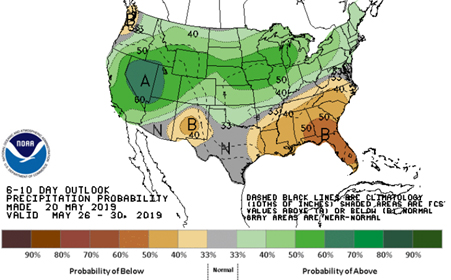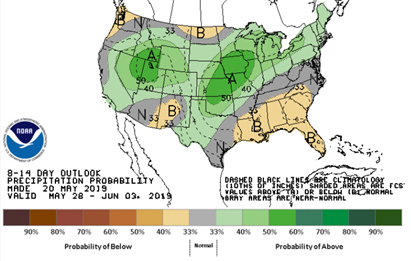USDA’s Crop Progress report for the week ended May 19 reported 51% of intended acres remain unplanted since USDA began this report, surpassing the prior highest number of 47%. The five-year average for this week is 80%.
Soybeans also are well behind average, at 19% complete vs. 47% the past five years.
In our local states, Iowa is in the best shape and South Dakota is in the worst.
|
CORN PLANTED
|
SOYBEANS PLANTED
|
|
May 19
|
5-year average
|
May 19
|
5-year average
|
| Iowa |
70
|
89
|
27
|
55
|
| Kansas |
61
|
80
|
17
|
29
|
| Nebraska |
70
|
86
|
40
|
54
|
| South Dakota |
19
|
76
|
4
|
39
|
| 18 States |
49
|
80
|
19
|
49
|
Only 19% of the corn crop has emerged, compared with a 49% average, while soybeans are 5% emerged, versus 17% on average.
Nebraska had the most days suitable for fieldwork in the week, at 5.0. There were only 2.7 days suitable in Iowa, 3.8 in Kansas, and 3.3 in South Dakota. The current week has started with saturated fields, widespread rains and cool temperatures.
With corn’s final planting date for crop insurance looming on May 31, the Climate Prediction Center puts the probability of rain from May 26-30 at well above normal through the Corn Belt.

The following time period (May 28-June 6) also favors rain.

Corn futures closed Monday at their highest price in nearly a year and wheat prices reached their highest level in three months on continued wet weather. The soybean market is less concerned about the U.S. crop given South America’s large harvest, reduced demand from China, where the African Swine Fever has cut the swine herd, and the impact of tariffs on U.S. exports.
Marketing advisory services point out that managed money traders have been holding large amounts of short positions, meaning they expected prices to fall. They held more than 483,000 contracts for the week of May 14 (see chart from ycharts.com). If they remain convinced this year’s crop will fall short of expectations because acres aren’t planted, they will buy back their short positions, contributing further to futures price strength.

This could be a year when Revenue Protection insurance shines with its opportunity for coverage to increase if fall prices rise, allowing producers to forward price their crop with the knowledge that the insurance will help cover bushels contracted but not grown. For more, visit frontierfarmcredit.com.
Winter wheat
Only 61% of the Kansas crop has headed, well behind the five-year average of 83%. In Frontier’s service area in the eastern third of the state (NE, EC and SE in the table below), the central and southern sections are ahead of the state average, while the northern section is far behind.
Concerns about the quality of the state’s wheat crop are rising in the face of continued wet weather, although 60% is still rated good/excellent and 10%, poor/very poor. This is slightly below USDA’s rating of the overall crop in its reporting states – 66% on the top end and 8% on the bottom end.
The state’s sunflower acreage reached 1% in the week ended May 19, close to the 3% average but lagging last year’s 6%.

